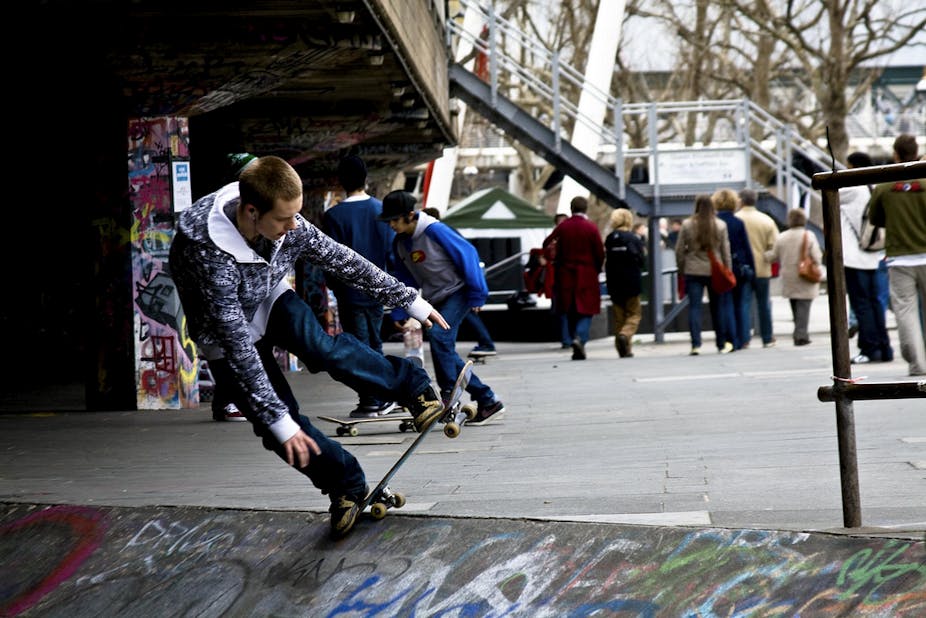A year-and-a-half after the Southbank Centre published its plans for the redeveloped Festival Wing that would have removed the skaters from their habitual haunt in the building’s undercroft, the plans have been scrapped. A joint statement by the centre and the campaign to save the skaters’ undercroft, Long Live South Bank, stated that it would be kept open without charge, seemingly indefinitely.
This is quite a reversal of Southbank’s stance, with the centre’s rhetoric throughout the campaign towards the skating community and LLSB shifting from caring sympathisers, to annoyed landlords with nuisance tenants, to aggressive name-calling. The project’s failure can be pinned to three, related issues.
First, there was the overwhelming groundswell of support for the skaters. The Southbank seemed surprised by this. For decades skaters have been treated as anti-social deviants, yet the community thrives as a form of urban practice and creativity with roots going back decades – and the undercroft was a central part of this scene before the Southbank took off as a go-to area for hoards of tourists and visitors (who like to watch them).
Skateboarders use the city in unexpected and different ways, ways in which planners did not intend, and private landowners often don’t like. But their continued presence in cities all over the world demonstrates its appeal and longevity.
The skateboarding subculture is tied into the subconsciousness of cities. So when a key cultural site is threatened by “big business”, it was hardly surprising to see others standing with them, including London’s mayor, Boris Johnson. The undercroft is not just another skate spot – it had been defended for decades, with skaters facing off efforts to marginalise and criminalise them.

New isn’t everything
The Southbank included an alternative skate park in their plans, described as “an area for urban arts”. This was a clear and transparent attempt to commercialise skating from the outset, and was a rather patronising gesture.
Skate parks have long existed as places where skaters can go to practice, socialise and perform in relative safety and comfort. But as spaces designed for that purpose, they remove the element of creative re-appropriation of the city that is part of the culture. Such parks represent a spoon-fed consumerism that goes against the grain.
The proposed skate park was not only extremely corporate in appearance, but represented a complete whitewashing (literally) of the undercroft’s history, and would undoubtedly have been branded, sponsored, overly-policed and micro-managed. It was seen as a transparent attempt not only to remove skaters from prime real estate, but also to impose greater control over them.
Unoriginal thinking
Third and perhaps more importantly is that of the capitalist logic at work behind the Southbank’s plans. While the Festival Wing plans were heralded as dynamic, creative and visionary, really they only recreated cityscapes that have proliferated across the world. Coffee chains, “boutique” retail stores (usually owned by larger corporations), food markets, pop-up events – these are all indicative of the march toward the privatisation of space. Capitalism has become extremely proficient at creatively adapting its aesthetic appeal, while maintaining the end result of further privatisation of land, centralisation of wealth, and homogenisation of cities.
The skaters recognised this early and were able to expose its inherent contradictions. Why would a “culture for all” not include skaters? If Southbank was really committed to broadening the cultural offerings, surely preserving the undercroft was paramount. It already attracts marginalised young people; it already allows them to form diverse communities around a shared common interest; it already promotes social interaction, healthy living, and cultural engagement. The desire to create more saleable retail space is not reason enough to destroy a community that already matches the aspects the Southbank wished to promote.
In an era when our cities are increasingly corporate, private and elitist, Long Live South Bank’s successful defence of the undercroft proves that democratic, grass-roots community activism still works, and it proves that our cities are still worth fighting for.

